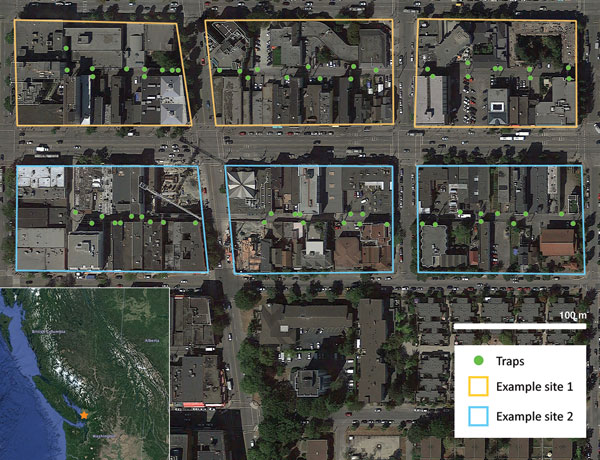Volume 24, Number 2—February 2018
Dispatch
Effects of Culling on Leptospira interrogans Carriage by Rats
Figure 1

Figure 1. Two example sites side-by-side in a study of the effects of culling on Leptospira interrogans carriage by rats, Vancouver, British Columbia, Canada, June 2016–January 2017. Each site comprised 3 city blocks connected by continuous alleys; individual sites that were trapped at the same time had parallel alleys separated by major roads and multiple buildings that, based on previous research (9,10), rats were assumed to be unlikely to move between. Five and 7 sites were randomly selected as intervention and control sites, respectively. In intervention sites, kill-trapping was conducted in the center of the 3 blocks; blocks flanking the intervention block were designated nonkill flanking blocks (nonkill flanking blocks were trapped to detect any indirect effects of kill-trapping, such as immigration from/emigration to the intervention block). Image downloaded from Google Earth Professional (https://www.google.com/earth/download/gep/agree.html).
References
- Guerra MA. Leptospirosis. J Am Vet Med Assoc. 2009;234:472–8, 430.
- Costa F, Hagan JE, Calcagno J, Kane M, Torgerson P, Martinez-Silveira MS, et al. Global morbidity and mortality of leptospirosis: a systematic review. PLoS Negl Trop Dis. 2015;9:e0003898–19. DOIPubMedGoogle Scholar
- Himsworth CG, Parsons KL, Jardine C, Patrick DM. Rats, cities, people, and pathogens: a systematic review and narrative synthesis of literature regarding the ecology of rat-associated zoonoses in urban centers. Vector Borne Zoonotic Dis. 2013;13:349–59. DOIPubMedGoogle Scholar
- Himsworth CG, Bidulka J, Parsons KL, Feng AYT, Tang P, Jardine CM, et al. Ecology of Leptospira interrogans in Norway rats (Rattus norvegicus) in an inner-city neighborhood of Vancouver, Canada. PLoS Negl Trop Dis. 2013;7:e2270–9. DOIPubMedGoogle Scholar
- Amman BR, Nyakarahuka L, McElroy AK, Dodd KA, Sealy TK, Schuh AJ, et al. Marburgvirus resurgence in Kitaka Mine bat population after extermination attempts, Uganda. Emerg Infect Dis. 2014;20:1761–4. DOIPubMedGoogle Scholar
- Donnelly CA, Woodroffe R, Cox DR, Bourne FJ, Cheeseman CL, Clifton-Hadley RS, et al. Positive and negative effects of widespread badger culling on tuberculosis in cattle. Nature. 2006;439:843–6. DOIPubMedGoogle Scholar
- Meyer A. Urban commensal rodent control: fact or fiction? In: Singleton GR, Hinds LA, Krebs CJ, Spratt DM, editors. ACIAR monograph series. Canberra (ACT, Australia): Australian Centre for International Agricultural Research; 2003. p. 446–50.
- Colvin BA, Jackson WB. Urban rodent control programs for the 21st century. In: Singleton GR, Hinds LA, Leirs H, Zhang Z, editors. ACIAR monograph series. Canberra (ACT, Australia): Australian Centre for International Agricultural Research; 1999. p. 243–57.
- Davis DE, Emlen JT, Stokes AW. Studies on home range in the brown rat. J Mammal. 1948;29:207–25. DOIGoogle Scholar
- Gardner-Santana LC, Norris DE, Fornadel CM, Hinson ER, Klein SL, Glass GE. Commensal ecology, urban landscapes, and their influence on the genetic characteristics of city-dwelling Norway rats (Rattus norvegicus). Mol Ecol. 2009;18:2766–78. DOIPubMedGoogle Scholar
- Dohoo I, Martin W, Stryhn H. Veterinary epidemiological research. Charlottetown (PEI, Canada): AVC Inc.; 2007.
- Cowan DP, Quy RJ, Lambert MS. Ecological perspectives on the management of commensal rodents. In: Singleton GR, Hinds LA, Krebs CJ, Spratt DM, editors. ACIAR Monograph series. Canberra (ACT, Australia): Australian Centre for International Agricultural Research; 2003. p. 433–39.
- Clapperton BK. A review of the current knowledge of rodent behaviour in relation to control devices. Science for conservation monograph series. Wellington (New Zealand): Science & Technical Publishing, New Zealand Department of Conservation; 2006.
- Himsworth CG, Bai Y, Kosoy MY, Wood H, DiBernardo A, Lindsay R, et al. An investigation of Bartonella spp., Rickettsia typhi, and Seoul hantavirus in rats (Rattus spp.) from an inner-city neighborhood of Vancouver, Canada: is pathogen presence a reflection of global and local rat population structure? Vector Borne Zoonotic Dis. 2015;15:21–6. DOIPubMedGoogle Scholar
- Himsworth CG, Miller RR, Montoya V, Hoang L, Romney MG, Al-Rawahi GN, et al. Carriage of methicillin-resistant Staphylococcus aureus by wild urban Norway rats (Rattus norvegicus). PLoS One. 2014;9:e87983–9. DOIPubMedGoogle Scholar